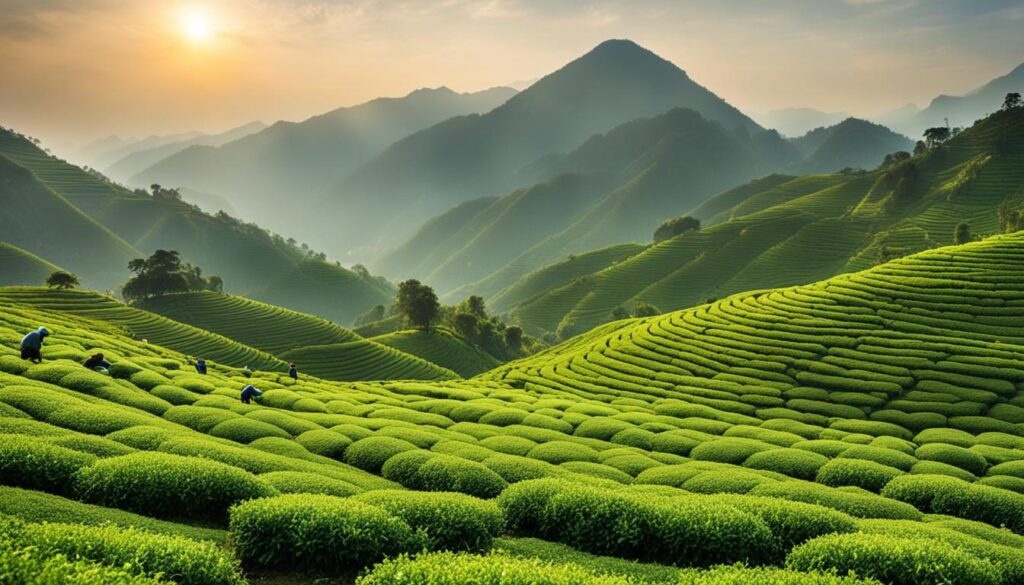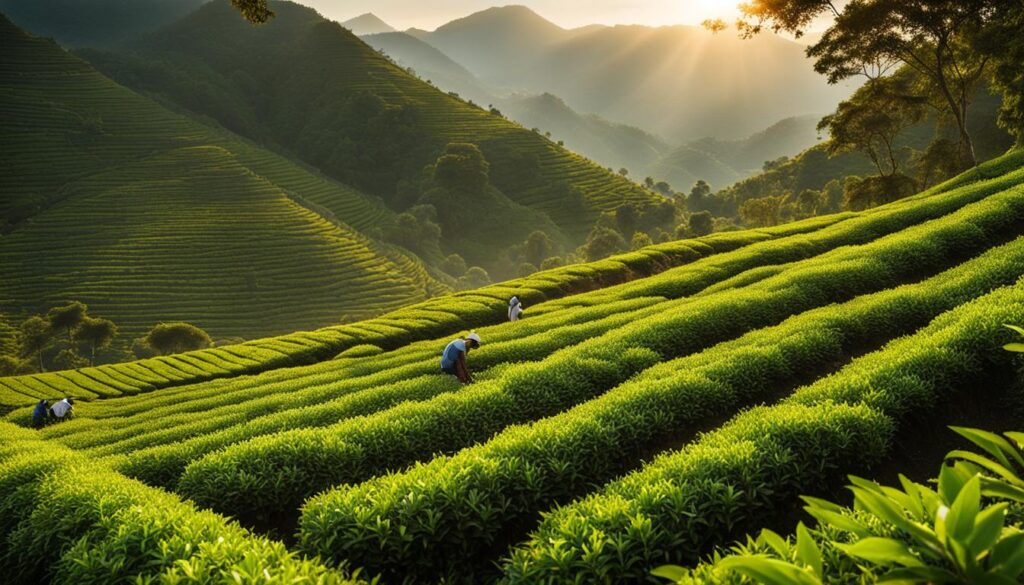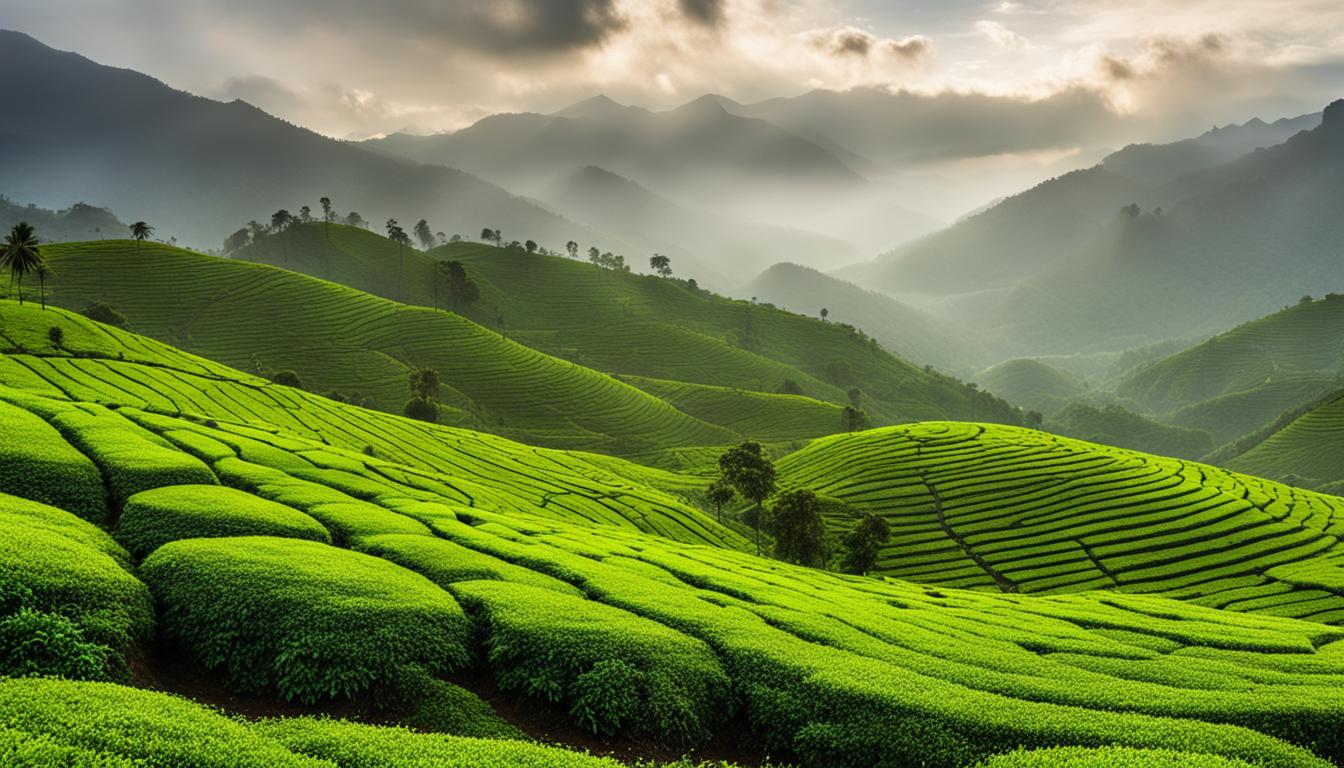Planning a visit to a tea estate and wondering when is the best time to go? Look no further! We’ve got you covered with our ultimate tea plantation visit seasonal guide. Discover the stunning beauty of tea fields in different seasons and immerse yourself in the world of tea production and culture.
Key Takeaways:
- Spring showcases the beauty of new shoots and the vibrant colors of the tea fields.
- Summer is the peak harvest season, offering a bustling atmosphere and a chance to witness the hard work of farmers.
- Autumn treats visitors to stunning foliage and abundant harvest, creating a picturesque setting.
- Winter provides a peaceful and tranquil experience, with snow-covered tea fields and a serene environment.
- Each season brings its own unique charm to tea estates, so plan your visit based on your preferred experience.
Spring – Witness the Beauty of New Shoots
In March, as the winter frost fades away, the tea fields come alive with the beauty of new shoots. This marks the beginning of spring, a season that brings a sense of renewal and growth to tea estates. As you stroll through the fields, you’ll be mesmerized by the sight of young tea leaves sprouting from the plants, a clear sign that the tea harvest is just around the corner.
April is an exciting time in tea production, as the new shoots continue to grow and develop. Depending on the type of tea being produced, some fields may be shaded to enhance the flavor and quality of the leaves. The art of shading is crucial for teas like gyokuro, kabuse sencha, and matcha, as it creates a unique taste profile that is highly sought after by tea enthusiasts.
As May approaches, the first harvest of the year begins. During this time, only a thin layer of young leaves is carefully plucked from the tea plants. It’s a delicate and meticulous process that requires the expertise of skilled farmers. In addition to harvesting, May is also a month for fertilizing and pest control in the tea fields, ensuring the health and vitality of the plants.
Tea Plantation Seasonal Travel Tips
- Plan your visit to tea estates during the months of March, April, and May to witness the beauty of new shoots and the beginning of the tea harvest.
- Take a guided tour to learn about the different types of tea being produced and the techniques used to maintain the fields.
- Consider visiting tea estates that offer tea tasting sessions, where you can experience the unique flavors and aromas of freshly brewed tea.
- Don’t forget to bring a camera to capture the vibrant colors and stunning landscapes of the tea fields during spring.
“Spring is a magical time in tea production. The sight of new shoots and the anticipation of the upcoming harvest create a sense of excitement and wonder. It’s a season that truly showcases the artistry and dedication of tea farmers.”
As you plan your visit to a tea estate, consider the unique experiences that each season offers. Spring provides a glimpse into the beauty of new growth and the beginning of the tea harvest. Take the time to appreciate the hard work and craftsmanship that goes into every cup of tea, and immerse yourself in the rich culture and history of tea production. Whether you’re a tea enthusiast or simply curious about the world of tea, a visit to a tea estate during spring is a must for any traveler.
Summer – Peak Harvest Time
Summer is an optimal season for tea farm tours, offering visitors a chance to witness the peak harvest of tea. The warm weather and lush green fields create a vibrant and bustling atmosphere in tea estates. The months of June and July mark the harvest of Yanagi Bancha, the middle layer of the tea plant. Although the leaves during this time contain fewer nutrients compared to the spring harvest, the abundance of tea leaves being plucked is a sight to behold.
In August, tea farmers focus on maintaining the health and productivity of the tea fields. Fertilizing and pest control measures are carried out to ensure the quality of the tea plants. Additionally, the sides of the bushes are trimmed to expose the plants to more sunlight, which helps the fertilizers work more effectively. This meticulous attention to detail is crucial in producing high-quality tea.
Visiting tea estates during summer also offers a unique opportunity to witness the preparations for the upcoming autumn harvest. Farmers are busy getting the fields ready, ensuring that everything is in place for the next harvest season. The energy and enthusiasm of the farmers during this time of the year are truly inspiring.
| Month | Activities |
|---|---|
| June | Harvest of Yanagi Bancha |
| July | Growth of new shoots |
| August | Fertilizing, pest control, and field maintenance |
Summer is a prime season for tea farm tours, where visitors can witness the bustling harvest and the meticulous care taken by farmers to ensure the quality of the tea plants.
Whether you’re passionate about tea production or simply enjoy the serene beauty of tea estates, summer offers a delightful experience for tea enthusiasts. Immerse yourself in the world of tea as you explore the vibrant fields, witness the dedicated work of farmers, and savor the flavors of freshly harvested tea leaves.

Autumn – Stunning Foliage and Abundant Harvest
Autumn is a breathtaking season to visit tea estates, with its stunning foliage and abundant harvest. As the days grow shorter and cooler, the tea plants undergo a remarkable transformation, displaying vibrant shades of red, orange, and yellow. The contrasting hues create a picturesque landscape that is truly a feast for the eyes. Walking through the tea fields during this season is like stepping into a painting.
In terms of tea production, autumn is a crucial time as well. October marks the start of the autumn harvest, which continues until early November. By this time, the tea plants have grown taller due to the three flushes, resulting in a higher yield. The lower part of the tea plant is typically harvested for cooking grade matcha, which is used in various culinary creations. It’s fascinating to witness the meticulous process of harvesting and processing leaves that will eventually end up as a delectable cup of tea.
| Month | Activities |
|---|---|
| October | Beginning of the autumn harvest; tea plants display vibrant foliage |
| November | Continuation of the harvest; lower part of tea plant harvested for cooking grade matcha |
The beauty of autumn extends beyond the tea fields. Many tea estates organize special events and festivals during this season to celebrate the harvest and showcase the local culture. Visitors can participate in tea tasting sessions, traditional tea ceremonies, and even try their hand at tea plucking. It’s a wonderful opportunity to immerse oneself in the rich history and traditions of tea production.
So, if you’re planning a visit to a tea estate, consider timing it during the autumn months. You’ll be greeted by nature’s stunning artwork, witness the tea harvest in full swing, and have the chance to partake in engaging cultural experiences. Autumn truly offers a unique and captivating atmosphere that will leave a lasting impression.

Winter – Quiet Season for Production
Winter is a serene and tranquil time in tea estates, making it a perfect season for tea garden tours. The cool weather and peaceful surroundings create a soothing atmosphere that allows visitors to fully immerse themselves in the beauty and culture of tea. While the production activities may be minimal during this season, the winter months are crucial for preparing the tea fields for the upcoming spring harvest.
In December, tea farmers focus on trimming the tea plants to ensure uniformity and promote the growth of new shoots. This process helps maintain the health of the plants and enhances their productivity. It is also a time to add organic fertilizer to the soil, providing essential nutrients for the tea plants during their dormant phase. By cutting the branches of surrounding trees, tea farmers maximize sun exposure and prevent frost damage, further ensuring the health of the tea plants.
Winter offers a unique opportunity to witness the meticulous care and preparation that goes into tea production. Though the fields may appear quiet, the dedication and hard work of the farmers are evident in their efforts to maintain and nurture the tea plants. Whether you prefer a bustling harvest season or a tranquil winter getaway, tea estates are a fascinating destination year-round.
Conclusion
Each season brings its own charm to tea estates, offering unique experiences for visitors. Spring showcases the beauty of new shoots, summer is the time of peak harvest, autumn impresses with stunning foliage, and winter provides a peaceful atmosphere. Whether you visit during the bustling harvest season or prefer a quiet winter getaway, tea estates offer a glimpse into the world of tea production and the hard work of farmers.
Plan your tea estate visit based on your preferred season and immerse yourself in the beauty and culture of tea. Explore the vibrant green spring fields, where the new shoots symbolize growth and rejuvenation. Experience the excitement of summer, as farmers diligently harvest the tea leaves at their peak. Marvel at the breathtaking autumn foliage, transforming the tea estates into a palette of red and green hues. Or escape to the tranquility of winter, where you can savor the serenity and observe the preparations for the upcoming season.
Each visit to a tea estate is an opportunity to connect with nature, appreciate the artistry of tea cultivation, and witness the dedication of the farmers. So pack your bags and embark on a tea adventure that suits your preferences. Remember, whether you sip a cup of tea on a sunny summer day or admire the snow-covered fields, the beauty and culture of tea will always leave you spellbound.
FAQ
When is the best time to visit tea estates?
The timing of your visit depends on the experience you’re looking for. Spring, summer, autumn, and winter each offer a unique charm, so plan your trip accordingly.
What is the best season to witness the beauty of new shoots?
Spring is the ideal time to see the tea fields come alive with new shoots. March and April are particularly stunning, with vivid green tea plants and cherry blossoms as the backdrop.
When is the peak harvest time for tea?
Summer, specifically June and July, is when tea farmers are busy with the peak harvest. It’s a bustling season in tea production, and you’ll have the opportunity to witness the hard work that goes into picking the leaves.
What makes autumn a great time to visit tea estates?
Autumn is a beautiful season to visit tea estates because of the vibrant foliage. The contrast between the red and green hues of the tea plants is simply breathtaking. The harvest also continues during this time, providing a unique experience.
Is winter a good time to visit tea estates?
While winter is a quiet season for tea production, it offers a serene and tranquil environment in the tea estates. If you prefer a peaceful getaway and want to enjoy the beauty of snow-covered fields, winter can be a great time to visit.
Why should I plan my tea estate visit based on the season?
Each season brings its own charm to tea estates, offering unique experiences for visitors. Whether you want to witness the beauty of new shoots in spring or immerse yourself in the bustling harvest season, planning your visit based on the season ensures you get the most out of your tea estate experience.





